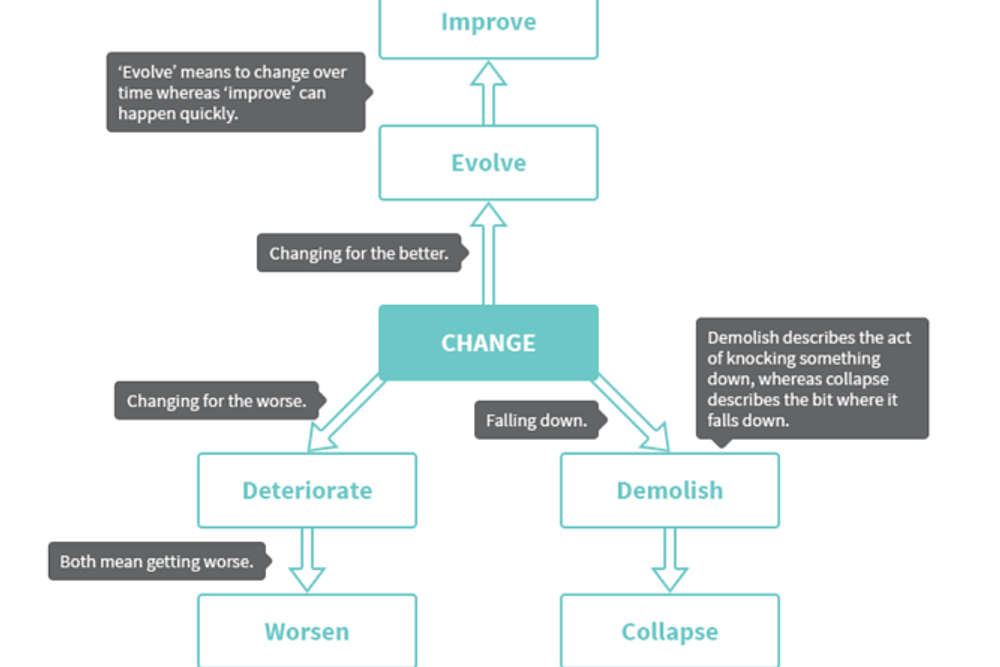1. Language lines
As all good teachers know, one of the keys to an effective assessment is creating a dialogue. To support this, the Education Endowment Foundation found in a recent study that there is “a strong case for providing dedicated time to consider and respond to marking in class.”
The Language Lines exercise is built on this teacher-student interaction, drawing on what the Literacy Shed refers to as the ‘wish’ strategy, where students would be asked to “add some adventurous vocabulary to an ineffectual sentence”, before allowing them to “action those comments in the next lesson”.
The problem was that writing ‘wishes’ could be time consuming. Instead, we created a quick and easy code of drawing straight lines and squiggly lines from ‘unadventurous’ language. Teaching learners the code, we asked them to respond by writing a synonym next to the straight line, and an antonym next to the squiggly line. This way, learners were able to improve their work, whilst being challenged to think deeply about their word choices and how they connect with the wider English language.
2. Semantic maps
The issue with asking students to use ‘adventurous’ language is that they always go to the same place: the thesaurus. Of course, thesauruses are excellent vocabulary resources, but all teachers are familiar with their limitations. How many times have you heard your students say: “the man was running promptly”, as opposed to “swiftly”?
If this happens, don’t worry – it’s an excellent teaching opportunity! Rather than writing “this doesn’t fit”, try helping them draw a semantic map. Encourage them to write the target word at the centre of a piece of paper, drawing lines from the word like a mind-web. At the end of each line, get them to write synonyms and related words, along with explanations of the words’ different connotations. In doing so, you will often help them understand why their word was unsuitable, leading them towards a better alternative. In the above example, for instance, your student may connect words like quick and swift, distinguishing them from prompt and punctual.

3. Self-identifying tiered language
Of course, the point of formative assessment strategies is to evaluate and improve our learners’ knowledge. Through our feedback, we want learners to become self-sufficient users of language, thinking carefully about their word choices. An excellent way of doing this is through ‘tiered language.’
Put simply, tiered language is a framework developed by Beck and McKeown (2002), whereby words are organised into different tiers. Tier 1 vocabulary is everyday language that most learners already know, including concrete nouns like “tree”. Tier 2 language is comprised of words that need explicit instruction. Usually, this is frequently used academic language that is necessary for cross-curricular comprehension – often abstract words like ambition or controversy.
Once you’ve explained this system to your students, you’re ready to bring out the highlighters!
Get your learners to read their written work and underline their usage of Tier 1 and 2 vocabulary in separate colours. Once they’re done, if your learners find they’re using mostly Tier 1 words, ask them how this language could be enhanced. If they make good suggestions – reward them! This way, you are motivating your class to be conscious of their own word choices, making them effective editors of their work.
4. Making metaphors
With your learners familiar with tiered language, it’s time to get deep and creative!
As Beck and McKeown explain in the above study, language learning is most effective when moved beyond basic definitional accuracy. To do this, students must see words in various contexts and think about vocabulary in different ways. This is why Making Metaphors – an exercise developed by Dr Robert Marzano – is one of the most fun and effective formative assessment strategies, when it comes to literacy improvement.
While the task itself is challenging, the concept is simple. All you have to do is highlight three Tier 2 words used by your learners, asking them to devise metaphors that characterise each term. To help, provide them with a basic template, which could look something like this: ____________ is/are ____________ because _____________.
Using this template, a Tier 2 word like ‘tempestuous’ could be metaphorically described as an angry sea. This is because the sea’s ‘anger’ captures the word’s meaning of strong emotion, while the image of an angry sea is evocative of how it can describe stormy weather. By moving beyond direct definitions, you can offer students a creative way of independently and actively processing the different concepts and connotations behind language.
5. Multiple choice quizzes
Finally, a spot of role reversal can be fun and empowering for learners. Why not let them be teachers for a day? After all, it’s exciting for them, and less work for you.
All your learners need to get started is a copy of their work, highlighted for Tier 1 language (using the formative assessment strategies above). Next, get them to target one of their Tier 1 words, challenging them to think of a synonym. Privately, the student must then write this synonym down, along with two other unrelated terms (perhaps an antonym or similar sounding word). With this, they can then create their own multiple choice quiz using the following template: ‘What’s another word for _____? a) _____, b) _____, or c) _____?’
Now, get them to test their quizzes on each other! If certain learners do particularly well, you may want to reward them, or maybe even challenge them to quiz you as well. We often find that learners find this task particularly fun when they can make their quizzes as tricky as possible. For instance, a particularly sneaky learner might ask: ‘What’s another word for rude?’ a) inconsiderate, b) inconsequential, or c) incomprehensible?
Of course, these aren’t the only formative assessment strategies you can use to improve your students’ vocabulary. If you have some of your own #MagicMarking methods, we’d love you to share them with us on Twitter.
And if you'd like an even simpler method of assessing and marking your learners' work, why not see how Bedrock Learning can help?





